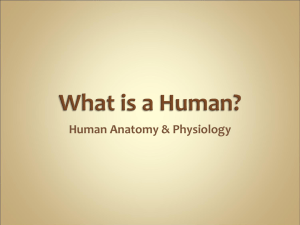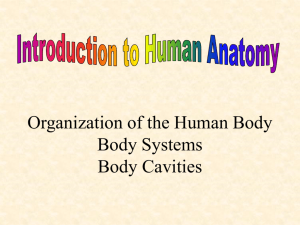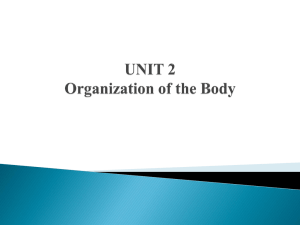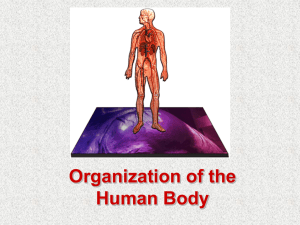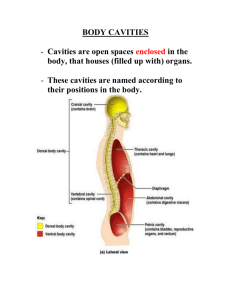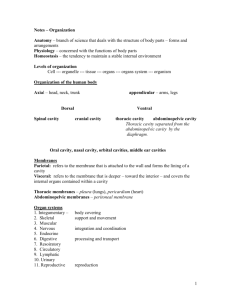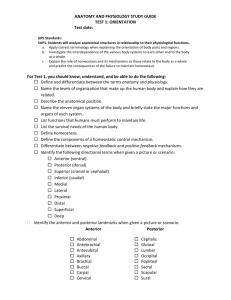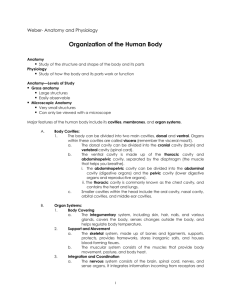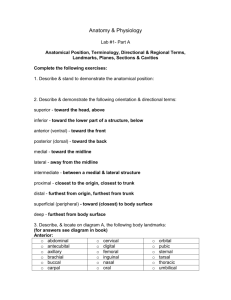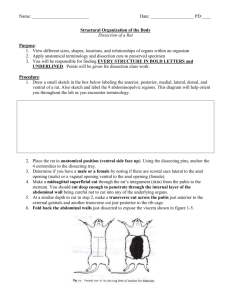Anatomy & Physiology - Moore Public Schools
advertisement
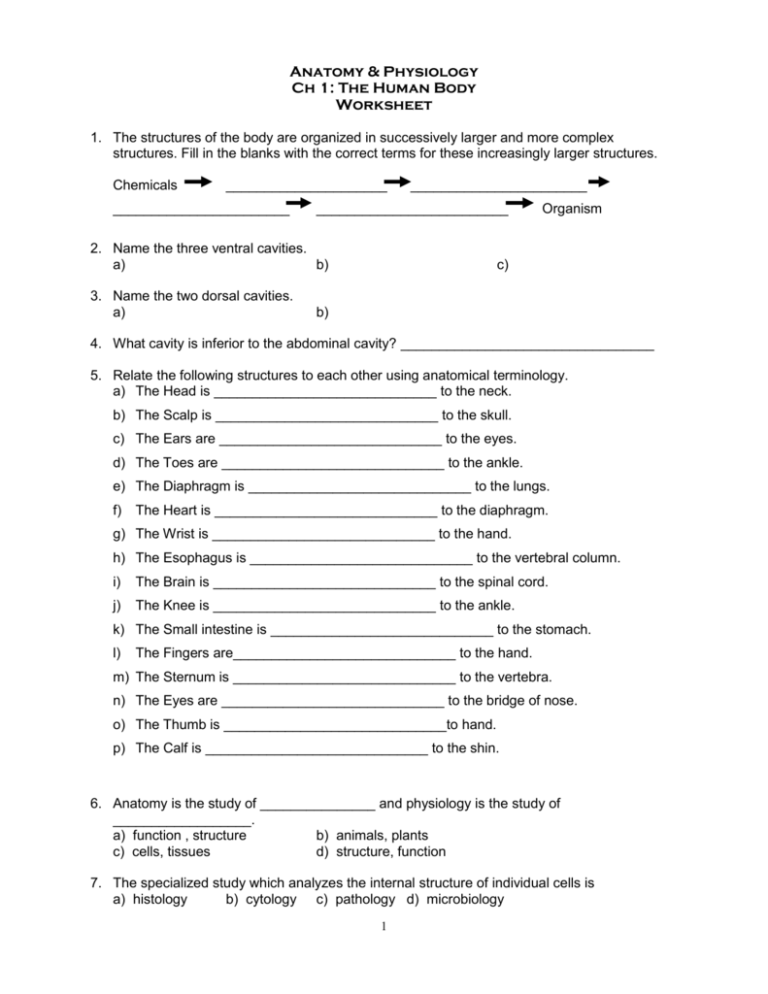
Anatomy & Physiology Ch 1: The Human Body Worksheet 1. The structures of the body are organized in successively larger and more complex structures. Fill in the blanks with the correct terms for these increasingly larger structures. Chemicals _____________________ _______________________ _______________________ _________________________ 2. Name the three ventral cavities. a) b) 3. Name the two dorsal cavities. a) Organism c) b) 4. What cavity is inferior to the abdominal cavity? _________________________________ 5. Relate the following structures to each other using anatomical terminology. a) The Head is _____________________________ to the neck. b) The Scalp is _____________________________ to the skull. c) The Ears are _____________________________ to the eyes. d) The Toes are _____________________________ to the ankle. e) The Diaphragm is _____________________________ to the lungs. f) The Heart is _____________________________ to the diaphragm. g) The Wrist is _____________________________ to the hand. h) The Esophagus is _____________________________ to the vertebral column. i) The Brain is _____________________________ to the spinal cord. j) The Knee is _____________________________ to the ankle. k) The Small intestine is _____________________________ to the stomach. l) The Fingers are_____________________________ to the hand. m) The Sternum is _____________________________ to the vertebra. n) The Eyes are _____________________________ to the bridge of nose. o) The Thumb is _____________________________to hand. p) The Calf is _____________________________ to the shin. 6. Anatomy is the study of _______________ and physiology is the study of __________________. a) function , structure b) animals, plants c) cells, tissues d) structure, function 7. The specialized study which analyzes the internal structure of individual cells is a) histology b) cytology c) pathology d) microbiology 1 8. The two regulatory systems of the body include the a) nervous & endocrine b) digestive & reproductive c) muscular & skeletal d) cardiovascular & pulmonary 9. Using the key choices, identify the body cavities where the following organs are located. A. Abdominal B. Cranial C. Pelvic D. Spinal E. Thoracic a) b) c) d) e) f) g) h) i) j) k) l) ____ Stomach ____ Small intestine ____ Spinal cord ____ Lungs ____ Spleen ____ Liver ____ Brain ____ Rectum ____ Urinary bladder ____ Gall bladder ____ Heart ____ Ovaries 10. Read the section about the organ systems of the body. Using the key choices, identify the body system to which the following organs or functions belong. Some will be used more than once. A. Cardiovascular E. Lymphatic I. Respiratory B. Digestive F. Muscular J. Skeletal C. Endocrine G. Nervous K. Urinary D. Integumentary H. Reproductive a) b) c) d) e) f) g) h) i) j) k) l) m) ____ Rids the body of nitrogen-containing wastes. ____ Contains the Brain, nerves and sensory receptors. ____ Provides support and levers on which the muscles can act. ____ Includes the heart and the blood vessels. ____ Protects underlying organs from mechanical damage and from drying out. ____ Breaks down food into small particles that can be absorbed. ____ Includes the kidneys, bladder, & ureters. ____ Includes the esophagus, large intestine, & stomach. ____ Delivers oxygen and nutrients to all parts of the body. ____ Controls the body with chemicals called hormones. ____ Includes the ovaries & uterus in women and the testes & vas deferens in men. ____ Moves the limbs and allows for facial expression. ____ Includes the pancreas, pituitary & adrenal glands. 11. Homeostasis refers to a) keeping the body parts in proper size & form b) treating illnesses with small doses of drugs c) interbreeding in groups of the same species d) stabilizing internal conditions in physiological systems 2 12. When a variation, outside of normal limits triggers an automatic response that corrects the situation, the mechanisms is called a) positive feedback b) crisis management c) negative feedback d) homeostasis 13. When the initial stimulus produces a response that exaggerates the stimulus, the mechanism is called a) autoregulation b) negative feedback c) extrinsic regulation d) positive feedback 14. Using the key choices, identify the following body parts or areas. A. Abdominal F. Crural K. Occipital P. Sural B. Axillary G. Digital L. Oral Q. Umbilical C. Brachial H. Femoral M. Orbital D. Buccal I. Gluteal N. Popliteal E. Cervical J. Lumbar O. Patellar a) b) c) d) e) f) g) h) i) j) k) l) m) n) ____ Armpit ____ Thigh ____ Belly button ____ Neck ____ Buttock ____ Fingers or toes ____ Posterior side of the head ____ Lower back area ____ Mouth ____ Upper arm ____ Knee cap ____ Shin ____ Calf ____ Eyes 15. When a person is lying down face up in the anatomical position, the individual is said to be a) prone b) rostral c) supine d) proximal 16. Making a sagittal section results in the separation of' a) anterior and posterior portions of the body b) superior and inferior portions of the body c) dorsal and ventral portions of the body d) right and left portions of the body 17. The subdivisions of the dorsal body cavity include the a) thoracic and abdominal cavity b) abdominal and pelvic cavity c) pericardial and pleural cavity d) cranial and spinal cavity 18. Which of the following is not a discipline of anatomy? a) developmental b) gross c) homeostatic d) systemic 19. Which subdivision of anatomy involves the study of organs that function together? a) developmental b) gross c) homeostatic 3 d) systemic 20. In a negative feedback mechanism a) the response of the effector is to depress or end the original stimulus b) the response of the effector is to enhance the original stimulus c) the effect is usually damaging to the body d) the physiological function is maintained within a narrow range 21. A coronal plane through the head a) could pass through both the nose and occiput b) could pass through both ears c) must pass through the mouth d) could lie in a horizontal plane 22. Which of these organs would not be cut by a midsagittal plane a) urinary bladder b) heart c) gallbladder d) small intestine 23. The dorsal aspect of the human body is also its a) anterior surface b) posterior surface c) lateral aspect d) superior aspect 24. An accident victim has a collapsed lung. Which cavity has been entered? a) dorsal b) thoracic c) pericardial d) vertebral 25. What are the five features of all living things? a) b) c) d) e) 26. The abdominal and thoracic cavities are separated by the _________________________. 27. The sum total of all the chemical processes occurring within an organism is _________________. 28. Nervous structures sensitive to a change in its environment are _____________________. 29. Define the following terms in your own words (NO Glossary Terms) a. b. c. d. e. f. g. h. i. j. k. l. Organ Organ System Ventral/Anterior Dorsal/Posterior Superior/Cranial Inferior/Caudal Medial Lateral Parietal/Superficial Visceral/Deep Thorax Abdomen 4 30. Label the Planes of the Body A. _______________________ B. _______________________ C A C. _______________________ B 31. Label the Body Cavities A. _______________________ G B. _______________________ F C. ___________________Wall D. _______________________ H E. _______________________ F. _______________________ B G. _______________________ C H. _______________________ D A E 5 32. On the following figure, label all the body parts using the correct anatomical terms. 6
